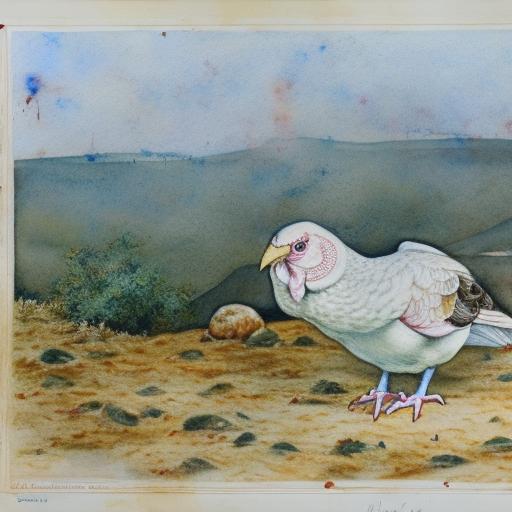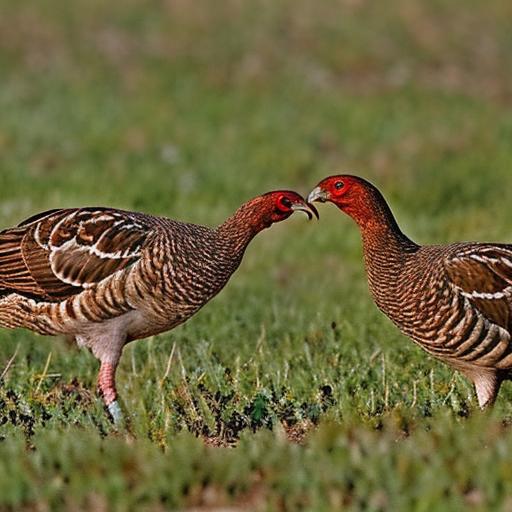White meat turkey breeding has a long and fascinating history that dates back to the early 20th century. The demand for white meat turkey has been steadily increasing, and as a result, breeders have been working to develop turkeys with larger breast muscles and higher meat yields. The first significant development in white meat turkey breeding occurred in the 1930s with the introduction of the Broad Breasted White turkey breed. This breed was specifically selected for its ability to produce large amounts of white meat, making it highly desirable for commercial production.
In the 1960s, the development of artificial insemination techniques revolutionized the turkey breeding industry, allowing breeders to select for specific traits and improve the overall quality of the birds. This led to the creation of the modern commercial turkey breeds that are widely used today. Over the years, selective breeding has continued to play a crucial role in the development of white meat turkeys, with breeders focusing on traits such as growth rate, feed efficiency, and breast muscle development. As a result, today’s white meat turkeys are significantly larger and more efficient at converting feed into meat than their predecessors.
Key Takeaways
- White meat turkey breeding has a long history dating back to the early 20th century, with the goal of producing turkeys with larger breast muscles for white meat production.
- Selective breeding plays a crucial role in developing turkeys with desirable traits such as fast growth, high meat yield, and disease resistance, leading to improved white meat production.
- Breeding techniques for white meat turkey include artificial insemination, genetic selection, and genomic technologies to enhance desirable traits and improve overall turkey health and welfare.
- Challenges in white meat turkey breeding include genetic diversity, disease resistance, and maintaining high meat quality while meeting consumer demand for white meat products.
- White meat turkey breeding has significantly impacted the industry by increasing meat yield, improving meat quality, and meeting consumer demand for white meat products, leading to economic growth and sustainability.
- Future trends in white meat turkey breeding may include the use of advanced genomic technologies, precision breeding, and sustainable breeding practices to address environmental and ethical concerns.
- Ethical considerations in white meat turkey breeding involve ensuring the health and welfare of turkeys, minimizing environmental impact, and addressing consumer concerns about animal welfare and sustainable farming practices.
The Importance of Selective Breeding for White Meat
Selective breeding is crucial for the production of white meat turkeys, as it allows breeders to improve specific traits that are desirable for commercial production. By carefully selecting birds with superior genetics, breeders can enhance traits such as growth rate, feed efficiency, and breast muscle development, ultimately leading to higher meat yields and improved profitability for producers. Additionally, selective breeding can also help to improve the overall health and welfare of the birds, as breeders can select for traits that make the turkeys more resilient to common diseases and environmental stressors.
Furthermore, selective breeding plays a vital role in meeting the increasing demand for white meat turkey. As consumer preferences continue to shift towards white meat, breeders must focus on developing turkeys that can efficiently produce large amounts of breast meat. Through selective breeding, breeders can ensure that the turkeys are able to meet these demands while maintaining high standards of quality and taste. Overall, selective breeding is essential for the continued success and sustainability of the white meat turkey industry, as it allows producers to meet consumer demands while also improving the efficiency and profitability of turkey production.
Breeding Techniques for White Meat Turkey
Breeding techniques for white meat turkey have evolved significantly over the years, with advancements in technology and genetics playing a crucial role in the development of modern commercial turkey breeds. One of the most significant advancements in turkey breeding has been the use of artificial insemination (AI), which allows breeders to select for specific traits and improve the overall quality of the birds. AI has revolutionized the industry by enabling breeders to use semen from superior males to inseminate a large number of females, resulting in improved genetics and more consistent offspring.
In addition to AI, modern breeding techniques also involve the use of genetic selection tools such as DNA testing and genomics. These tools allow breeders to identify specific genes associated with desirable traits such as growth rate, feed efficiency, and breast muscle development. By using this information, breeders can make more informed breeding decisions and accelerate the genetic progress of their turkey flocks. Furthermore, advancements in reproductive technologies such as embryo transfer and cryopreservation have also contributed to the development of superior turkey genetics. These techniques allow breeders to preserve and propagate valuable genetic lines, ultimately leading to improved performance and productivity in commercial turkey production.
Challenges in White Meat Turkey Breeding
While white meat turkey breeding has seen significant advancements, it also faces several challenges that breeders must navigate to ensure continued success and sustainability. One of the primary challenges is maintaining genetic diversity within commercial turkey breeds. As selective breeding focuses on specific traits, there is a risk of reducing genetic diversity within the population, which can lead to increased susceptibility to diseases and environmental stressors. To address this challenge, breeders must carefully manage their breeding programs to maintain genetic diversity while still improving desirable traits.
Another challenge in white meat turkey breeding is balancing growth rate and feed efficiency with animal welfare considerations. Selective breeding for rapid growth and high feed efficiency can lead to issues such as skeletal deformities and cardiovascular problems in turkeys. Breeders must carefully consider these welfare concerns when making breeding decisions and work towards developing turkeys that can efficiently convert feed into meat without compromising their overall health and well-being. Additionally, consumer demand for more sustainably produced turkey meat presents a challenge for breeders, as they must consider environmental impact and resource utilization when developing new breeds.
The Impact of White Meat Turkey Breeding on the Industry
The impact of white meat turkey breeding on the industry has been significant, with advancements in genetics and breeding techniques leading to improved productivity, efficiency, and profitability for producers. Through selective breeding, breeders have been able to develop turkeys with larger breast muscles and higher meat yields, meeting the increasing demand for white meat among consumers. This has resulted in a more sustainable and profitable industry, as producers are able to efficiently meet consumer demands while maintaining high standards of quality and taste.
Furthermore, white meat turkey breeding has also contributed to advancements in animal welfare and health within the industry. By selectively breeding for traits that improve overall bird health and resilience, breeders have been able to reduce disease susceptibility and improve the overall well-being of commercial turkey flocks. This has not only benefited the turkeys themselves but has also improved the overall sustainability and ethical considerations of turkey production. Overall, white meat turkey breeding has had a profound impact on the industry by driving improvements in productivity, efficiency, and animal welfare.
Future Trends in White Meat Turkey Breeding

Looking ahead, there are several key trends that are likely to shape the future of white meat turkey breeding. One of the most significant trends is the continued use of advanced genetic selection tools such as DNA testing and genomics. These tools will allow breeders to further accelerate genetic progress and develop turkeys with even greater efficiency and productivity. Additionally, advancements in reproductive technologies such as embryo transfer and cryopreservation are likely to become more widespread, enabling breeders to preserve valuable genetic lines and propagate superior traits within commercial turkey breeds.
Another important trend in white meat turkey breeding is the increasing focus on sustainability and environmental impact. As consumer demand for sustainably produced turkey meat continues to grow, breeders will need to consider environmental factors when making breeding decisions. This may involve developing turkeys that are more efficient at converting feed into meat or reducing resource utilization within production systems. Furthermore, there is likely to be an increased emphasis on animal welfare considerations within breeding programs, with a focus on developing turkeys that are not only productive but also resilient and healthy.
Ethical Considerations in White Meat Turkey Breeding
Ethical considerations play a crucial role in white meat turkey breeding, as breeders must balance genetic improvement with animal welfare concerns to ensure the well-being of commercial turkey flocks. Selective breeding for specific traits such as growth rate and feed efficiency must be carefully managed to avoid compromising the overall health and welfare of the turkeys. Breeders must prioritize traits that improve bird resilience and reduce disease susceptibility while still meeting consumer demands for white meat.
Additionally, ethical considerations also extend to environmental impact and resource utilization within commercial turkey production. Breeders must consider factors such as water usage, land management, and greenhouse gas emissions when making breeding decisions to ensure that their practices are sustainable and environmentally responsible. Furthermore, transparency and communication with consumers about breeding practices and animal welfare considerations are essential for maintaining public trust and confidence in the white meat turkey industry.
In conclusion, white meat turkey breeding has a rich history that has seen significant advancements in genetics and breeding techniques over the years. Selective breeding plays a crucial role in developing turkeys with larger breast muscles and higher meat yields while also improving overall bird health and resilience. However, breeders must navigate challenges such as maintaining genetic diversity and balancing growth rate with animal welfare considerations to ensure continued success and sustainability within the industry. Looking ahead, future trends in white meat turkey breeding are likely to focus on advanced genetic selection tools, sustainability, and animal welfare considerations. Ethical considerations will continue to be a priority for breeders as they work towards developing turkeys that are not only productive but also resilient, healthy, and sustainably produced.
If you’re interested in learning more about white meat turkey breeding, you may also want to check out an article on Poultry Wizard about the best coop for chickens. The article discusses the importance of providing a suitable environment for chickens to thrive and lays out the benefits of using the Producers Pride Sentinel Chicken Coop. It’s a great resource for anyone looking to improve their poultry farming practices. You can find the article here.
FAQs
What is white meat turkey breeding?
White meat turkey breeding refers to the selective breeding of turkeys to produce birds with a higher proportion of white meat, which is preferred by consumers. This involves breeding turkeys with desirable traits such as fast growth, high meat yield, and good feed conversion.
What are the goals of white meat turkey breeding?
The primary goals of white meat turkey breeding are to produce turkeys that grow quickly, have a high meat yield, and produce quality white meat. Breeders also aim to improve feed efficiency, disease resistance, and overall bird health.
How is white meat turkey breeding carried out?
White meat turkey breeding is carried out through selective mating of turkeys with desirable traits. Breeders use techniques such as artificial insemination and genetic selection to achieve the desired characteristics in the offspring. This process involves careful monitoring of traits such as growth rate, meat yield, and feed conversion.
What are some common white meat turkey breeds used in breeding programs?
Some common white meat turkey breeds used in breeding programs include the Broad Breasted White and the Hybrid Converter. These breeds have been selected for their fast growth, high meat yield, and white feather coloration.
What are the benefits of white meat turkey breeding?
The benefits of white meat turkey breeding include improved meat quality, higher meat yield, and increased efficiency in turkey production. Breeding programs also aim to improve the overall health and welfare of turkeys, as well as reduce the environmental impact of turkey farming.
Meet Walter, the feathered-friend fanatic of Florida! Nestled in the sunshine state, Walter struts through life with his feathered companions, clucking his way to happiness. With a coop that’s fancier than a five-star hotel, he’s the Don Juan of the chicken world. When he’s not teaching his hens to do the cha-cha, you’ll find him in a heated debate with his prized rooster, Sir Clucks-a-Lot. Walter’s poultry passion is no yolk; he’s the sunny-side-up guy you never knew you needed in your flock of friends!







